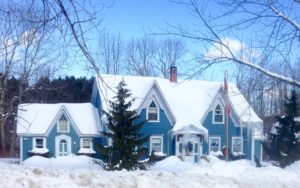Is Your Home Ready For Winters?
 Colder drafts, snow storms and blizzard. Winters bring a whole hog of new challenges for home owners. With a brand-new winter wardrobe, you may be all set to embrace winters. But is your home ready for winters too? Whether it is insulation, maintenance of heating systems or dealing with the possibility of frozen pipes, there is a lot you need to consider ahead of winters to ensure a safe and risk-free season.
Colder drafts, snow storms and blizzard. Winters bring a whole hog of new challenges for home owners. With a brand-new winter wardrobe, you may be all set to embrace winters. But is your home ready for winters too? Whether it is insulation, maintenance of heating systems or dealing with the possibility of frozen pipes, there is a lot you need to consider ahead of winters to ensure a safe and risk-free season.
And unless you are prepared, you could find yourself with hefty repair bills that can run into thousands of dollars. We will give you quick, doable list so that you can make your home ready for winters.
- Prevent frozen pipes:
As temperatures drop, water in the pipes can freeze and this can cause the pipes to burst. And remember some pipes are more vulnerable to this kind of damage than others. For example, pipes in the areas that don’t receive much heat such as basement, garage, attic and kitchen cabinets are more likely to freeze. Same goes for pipes that run across the walls that have no insulation. What can you do to avoid this?
- First, drain water from your outdoor faucets.
- Use UL listed heat tapes or insulation pipe sleeves to keep the pipes warm.
- Consider adding insulation to garage attics, basements and any other parts of your home that receive less heat.
- Keep water flowing through the faucet even at a trickle, if you think there is risk.
- Keep kitchen and bathroom cabinets, where most of the pipes are located, open to allow warm air to reach the plumbing in these cold areas. This will help to keep the pipes warm. At the same time, remove any harmful chemicals like household cleaners or medicines so that your children and pets can’t reach them.
- Going on a vacation or a business trip? If you are going to be away from home, it is recommended that you leave the heat on.
- Be prepared for the worst. If at all pipes burst in spite of taking all the precautions, turn off the master source for water to reduce damage caused by leaking.
- Get your heating systems ready and tuned up:
Have a professional come over and thoroughly inspect your furnace, vents and chimneys. And make sure you get everything cleaned and repaired well in time, ideally in fall, to avoid break-down and inconvenience in the middle of a cold night. Check on the batteries on smoke alarms and carbon monoxide detectors, and replace if needed.
- Add insulation and weather strip doors and windows:
Chilly winter air can enter through gaps around doors and windows, causing your heating systems to overwork and keeping your electricity bills high. Add insulation to walls and attics (remember this also allows pipes here to be warm), and caulk or weather strip for any gaps around doors and windows.
These efforts will help you reduce heat loss and keep utility bills within range. You can also install window screens or plastic shrink film to insulate your windows and replace any broken windows.
- Clear the gutters:
Your gutters and downspouts navigate water into the drainage, keeping it from getting accumulated. Leaves, twigs and other debris can clog these systems, thus blocking rain and melted snow to drain out. This can result in the formation of ice dams on the roof making water to eventually seep through ceilings and walls. This means heavy damage to the overall structure and foundation. You can prevent this by removing any obstruction and cleaning the gutter. Once done, make sure gutters and downspouts are not congested anymore by running water through. The best time to do this exercise is after the fall, when leaves have fallen.
- Repair leaky or damaged roofs:
Cold weather can spell doom for old or damaged roofs. Build up snow and ice can weigh down your roof, causing it to collapse. Roof-cave ins in winters can be avoided by tending to any damage or leaks beforehand. Your local contractor can check if your roof is strong enough to withstand the weight of a heavy snowfall. In addition, consider insulating your attic. This not only help minimize heat loss (read low energy bills) and keep pipes from freezing but prevents ice dams to form and allows snow on the roof to melt off.
